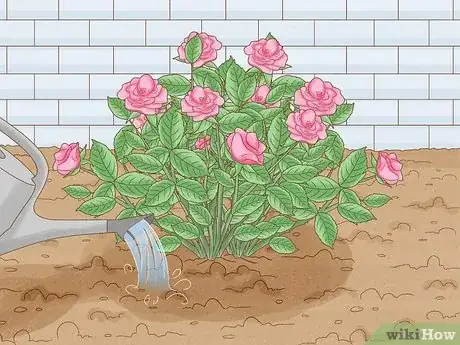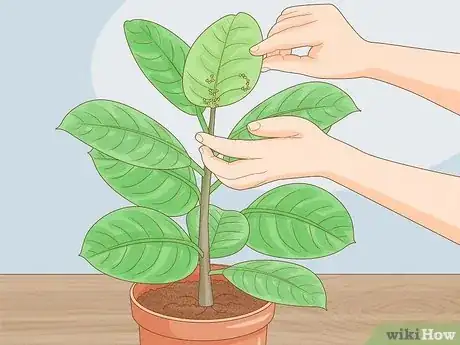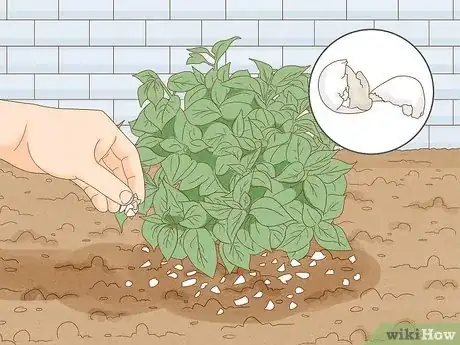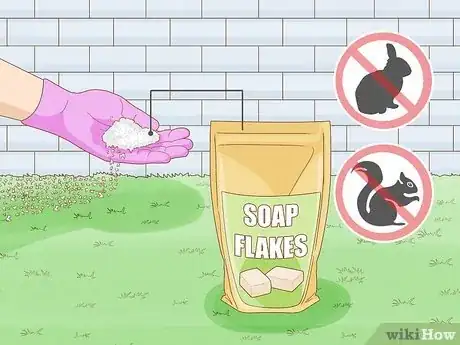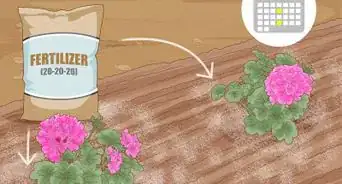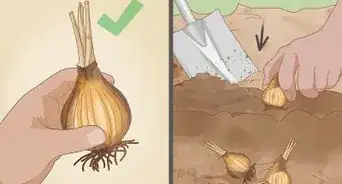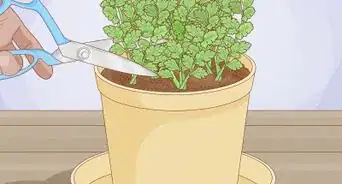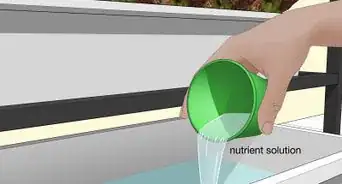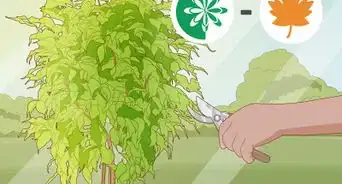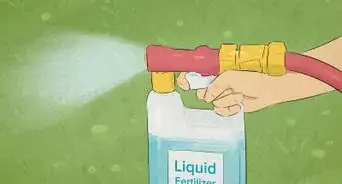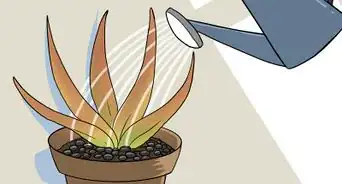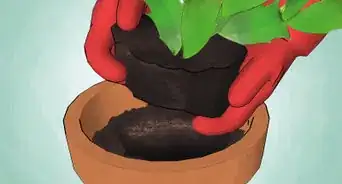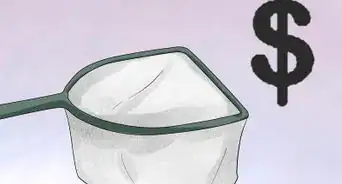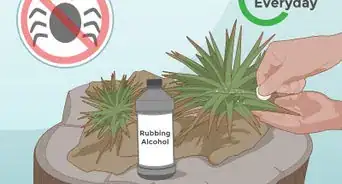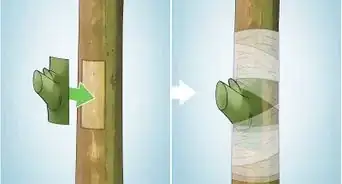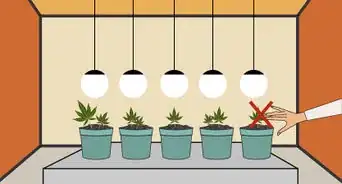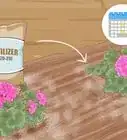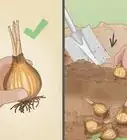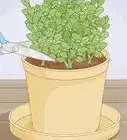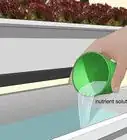This article was co-authored by Andrew Carberry, MPH. Andrew Carberry is a Food Systems Expert and the Senior Program Associate at the Wallace Centere at Winrock International in Little Rock, Arkansas. He has worked in food systems since 2008 and has experience working on farm-to-school projects, food safety programs, and working with local and state coalitions in Arkansas. He is a graduate of the College of William and Mary and holds a Masters degree in public health and nutrition from the University of Tennessee.
There are 7 references cited in this article, which can be found at the bottom of the page.
wikiHow marks an article as reader-approved once it receives enough positive feedback. In this case, 80% of readers who voted found the article helpful, earning it our reader-approved status.
This article has been viewed 559,121 times.
Taking care of plants can be very rewarding, even if the plant is a fern and doesn't produce fragrant flowers. This wikiHow will give you lots of tips on how to grow healthy plants.
Steps
Creating the Right Environmental Conditions
-
1Know your plants. No matter how much care and attention you give to plants, they aren't going to thrive if you don't know their specific needs. This is true whether you're buying a houseplant or planning an outdoor vegetable or flower garden. Some plants are able to do well in a variety of climates, but others require a controlled environment or can only survive in a specific region.
- Before planting a garden or adding a plant to your potted collection, search online or ask an expert at a nursery questions about what conditions the plants need.
- Figure out in what region the plants do best. Just because a plant isn't native to your area doesn't mean you can't grow it, but it's usually much easier to grow plants that do well in your region's climate, temperature and soil.
- For indoor plants, maintain a fairly steady temperature. If you're cold, your plant is cold, too. Avoid putting your green friends in drafty places. If you think it's chilly, so do they.[1]
-
2Make sure the container or pot you are using is big enough. Plants need room to grow. A sure fire plant killer is allowing the roots to become crowded. If you're planting directly in the ground, be sure to allow enough space between plants.
- If you have your plants in pots, then check the roots once per year to see if they look crowded. If they do, then break them up and repot your plant in a larger pot. This will promote new growth.[2]
- If you don't want to transfer to a larger container, then you can also trim the roots and then repot the plant.
Advertisement -
3Provide the right amount of sunlight. Plants generally need either full sunlight, partial sunlight, or partial shade. This relatively simple distinction has a big impact on how well plants do.[3]
- Take a look at your yard before purchasing plants. Note how much sun the different areas in the yard get before you figure out which plants to buy.
- If you're plotting a garden, arrange it so that part of the garden is shaded and part of it is exposed, so that you'll have a place for the different types of plants you buy.
- Most house plants do best in partial shade, which works out well since indoor areas don't usually get full sun. Keep this in mind before you decide to put a potted plant in a place where it will get hours of direct sunlight; you may end up exposing it for too long.
- If you notice your plant becoming thin and reaching toward the light, it needs to be closer to the sunshine.
Providing Water and Food
-
1Water the plants only as often as needed. Watering can cause perfectly lovely people to become serial plant killers. They either water too little or too much. Many first-time gardeners or potted plant owners water plants more than necessary, believing that the more water the plant gets, the better. This is true for certain plants, but too much water can kill other plants.
- Aside from doing research to find out how much water your plants need, here's a trick to help you tell when and how much to water: stick your finger in the dirt about an inch or so. In most cases, you should water your plants when the soil is slightly dry. Pour in enough water so that a little comes out the hole in the bottom of the pot. Avoid flooding the plant with too much water.
- Make sure that the pots you use have good drainage or the roots may get what is called “wet feet.” This can have a negative effect on your plant.
- Succulents and other plants acclimated to dry regions usually need less water than plants from wetter regions. They need to dry out completely between waterings.
- Seedlings generally need more water than adult plants. Keep seedlings constantly moist until they sprout several inches above the soil.
- Finicky plants like orchids need higher quality water, since they're sensitive to chemicals found in tap water. Use distilled or spring water instead.
-
2Fertilize. Most avid plant growers use some sort of fertilizer, but that's a matter of preference. If you choose to use fertilizer, visit your local greenhouse and ask questions about what to use and how much.[4]
- Find out the optimal soil makeup for your plants. Get your soil tested before you plant anything in the ground. You can take soil samples to your local extension office for testing.
- Consider using compost.[5] Composted fruits and vegetables make for rich, nutritious soil that is great for growing most plants. Keep in mind that some plants, like many species of wildflowers, actually prefer poor soil conditions, so do research to figure out what your plants need before using compost. You can use blood meal, composted poultry litter, or fish emulsion to fertilize your soil.
Using Tricks to Make Plants Thrive
-
1Check your plants often. You should be checking your indoor plants weekly and outdoor plants at least every other day to see how they are doing. This will help you to detect any problems before they get out of hand. Make checking your plants a part of your routine.
- For example, you could start your day every Saturday by checking all of your houseplants, or you could take a stroll through your garden every day or every other day before you head to work.
-
2Bury banana peels under rosebushes. Roses need a lot of potassium, which is readily available in bananas. Take out the banana and bury the peel in the soil just under the roots of the rosebush. The potassium will nourish the rosebush throughout its growing season.
-
3Use crushed eggshells to feed plants. Eggshells leach valuable nutrients into the soil, helping plants like tomatoes thrive throughout the season. Crush up a few and sprinkle them into the holes you dig for each plant, or into the bottom of a pot you're using for an indoor potted plant.
- Crushed eggshells nourish pepper and tomato plants, helping them bear delicious, flavorful fruit.
- Eggshells also serve as a natural alternative to pesticides, since they prevent slugs and other pests from attacking plants.[6]
-
4Keep pests away with soap. Outdoor plants are susceptible to getting nibbled on by rabbits, squirrels and other creatures. Keep them away by sprinkling flakes of soap around the garden. Some gardeners also swear by using human hair or predator urine to keep animals away.
-
5Use coins to keep slugs out. Shower a few pennies into your garden if you're having trouble keeping slugs away from your plants. They're repelled by the metal.[7]
Expert Q&A
-
QuestionDo banana peels really have readily available potassium? Don't they need to be composted?
 Andrew Carberry, MPHAndrew Carberry is a Food Systems Expert and the Senior Program Associate at the Wallace Centere at Winrock International in Little Rock, Arkansas. He has worked in food systems since 2008 and has experience working on farm-to-school projects, food safety programs, and working with local and state coalitions in Arkansas. He is a graduate of the College of William and Mary and holds a Masters degree in public health and nutrition from the University of Tennessee.
Andrew Carberry, MPHAndrew Carberry is a Food Systems Expert and the Senior Program Associate at the Wallace Centere at Winrock International in Little Rock, Arkansas. He has worked in food systems since 2008 and has experience working on farm-to-school projects, food safety programs, and working with local and state coalitions in Arkansas. He is a graduate of the College of William and Mary and holds a Masters degree in public health and nutrition from the University of Tennessee.
Food Systems Expert The nutrients in the peel will become available to the soil as the peel decomposes. They aren't readily available, but will slowly release over time.
The nutrients in the peel will become available to the soil as the peel decomposes. They aren't readily available, but will slowly release over time. -
QuestionHow do you care for aloe Vera plants inside?
 Andrew Carberry, MPHAndrew Carberry is a Food Systems Expert and the Senior Program Associate at the Wallace Centere at Winrock International in Little Rock, Arkansas. He has worked in food systems since 2008 and has experience working on farm-to-school projects, food safety programs, and working with local and state coalitions in Arkansas. He is a graduate of the College of William and Mary and holds a Masters degree in public health and nutrition from the University of Tennessee.
Andrew Carberry, MPHAndrew Carberry is a Food Systems Expert and the Senior Program Associate at the Wallace Centere at Winrock International in Little Rock, Arkansas. He has worked in food systems since 2008 and has experience working on farm-to-school projects, food safety programs, and working with local and state coalitions in Arkansas. He is a graduate of the College of William and Mary and holds a Masters degree in public health and nutrition from the University of Tennessee.
Food Systems Expert Aloe Vera is a great houseplant. It needs a sunny location, and a pot with well draining soil. Water it weekly at most, allowing the soil to dry out between waterings.
Aloe Vera is a great houseplant. It needs a sunny location, and a pot with well draining soil. Water it weekly at most, allowing the soil to dry out between waterings. -
QuestionWhat should I do if a plant I repotted isn't growing?
 Community AnswerYour plant might be not getting enough nutrients, water, or sunlight. It could even be something small, like not being buried deep enough. Try giving your plant some plant food and giving it some time to adjust.
Community AnswerYour plant might be not getting enough nutrients, water, or sunlight. It could even be something small, like not being buried deep enough. Try giving your plant some plant food and giving it some time to adjust.
References
- ↑ https://www.lifehack.org/390369/10-indoor-plants-that-are-easy-take-care
- ↑ http://pistilsnursery.com/how-to-repot-indoor-plants/
- ↑ https://www.dummies.com/home-garden/gardening/flower-gardening/how-much-light-do-plants-need/
- ↑ https://morningchores.com/fertilizing-plants/
- ↑ https://earthmatter.org/wp-content/uploads/2016/08/tip-sheet-how-to-use-compost-cpts-htuc-f.pdf
- ↑ http://homeguides.sfgate.com/plants-would-benefit-crushed-eggshells-40104.html
- ↑ https://www.theguardian.com/lifeandstyle/2014/aug/08/five-steps-gardeners-take-control-of-slugs-natural-way
About This Article
The best way to grow healthy plants is by providing water, nutrients, and the proper environmental conditions for your type of plant. Research how much sunlight and space your plants need before planting. Water your plants when the soil is dry to the touch, and fertilize your plants around twice a week. For advice from our Gardener on how to keep your plants thriving, check out the tricks below!



